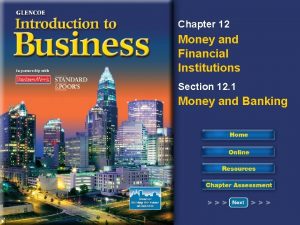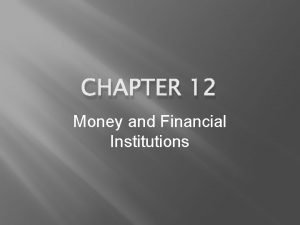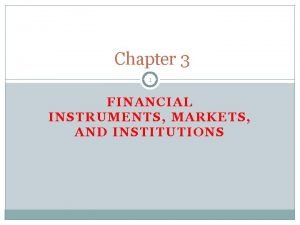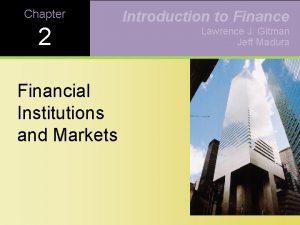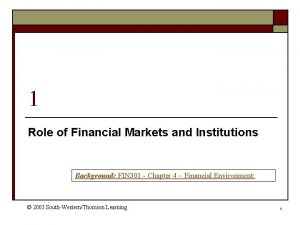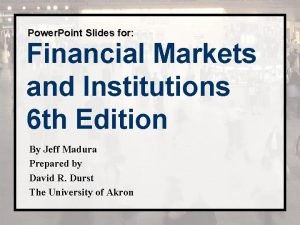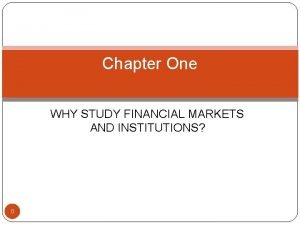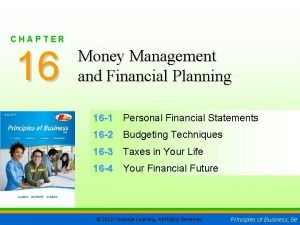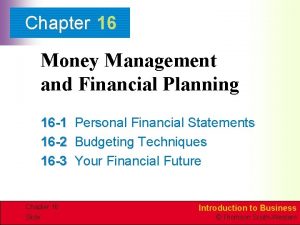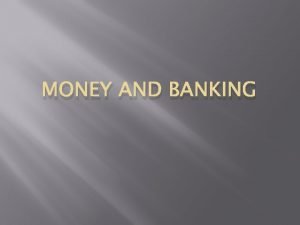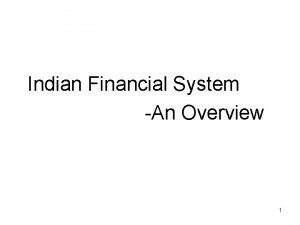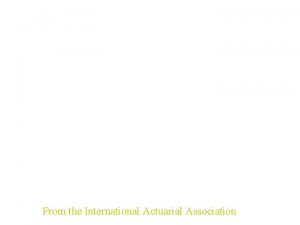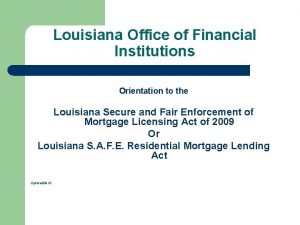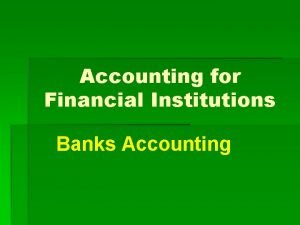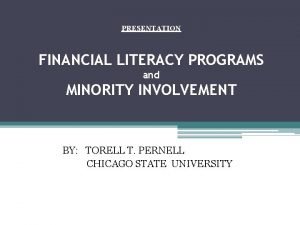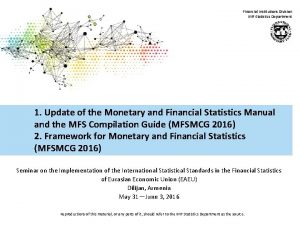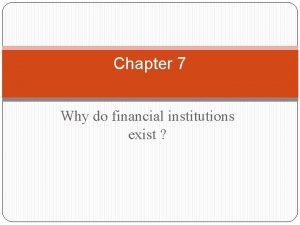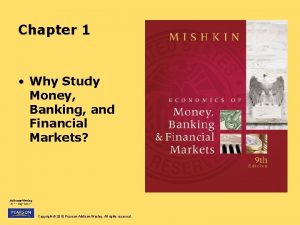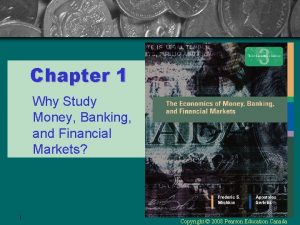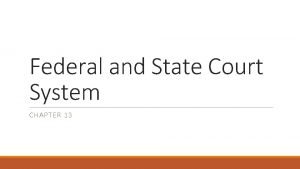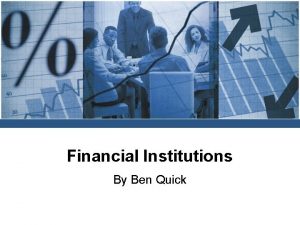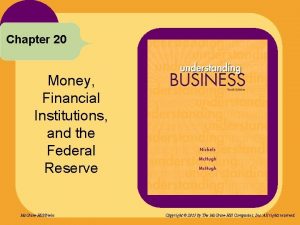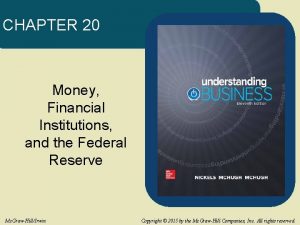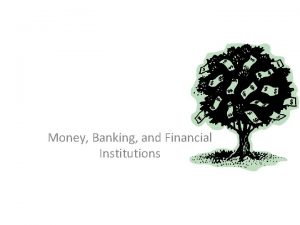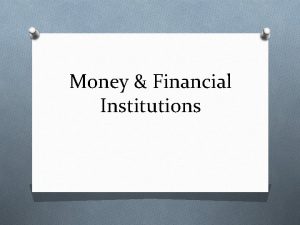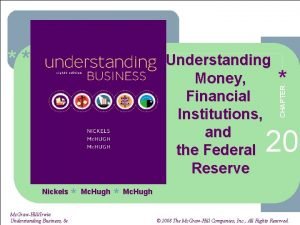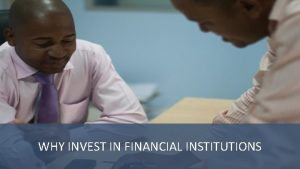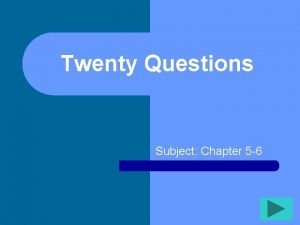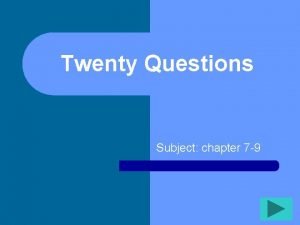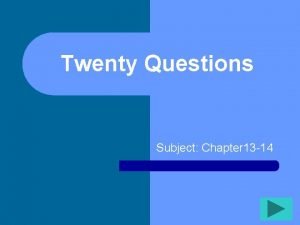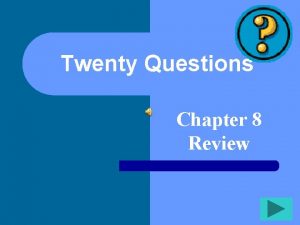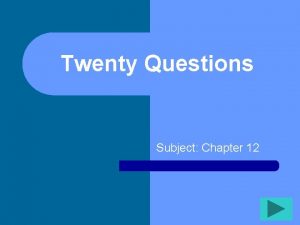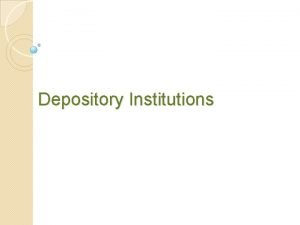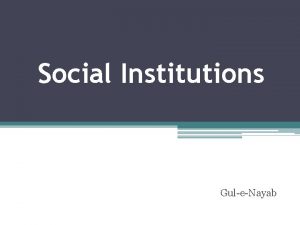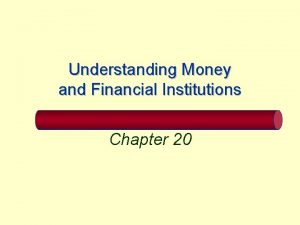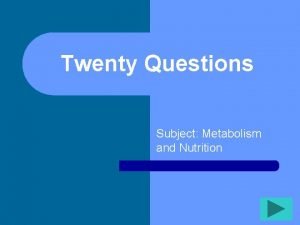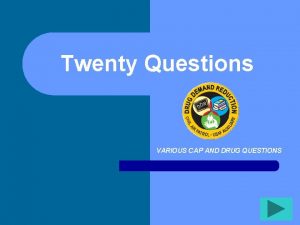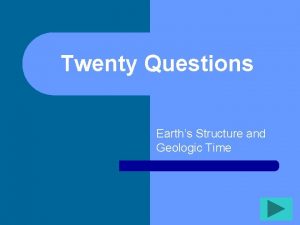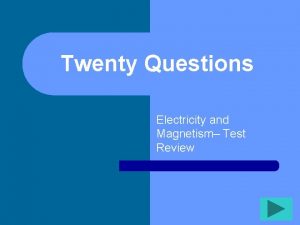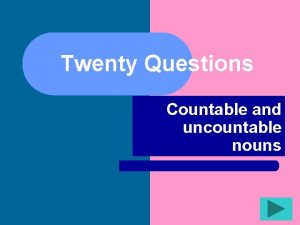Chapter Twenty Money Financial Institutions and the Federal

































- Slides: 33

* Chapter Twenty * Money, Financial Institutions, and the Federal Reserve Mc. Graw-Hill/Irwin Copyright © 2010 by the Mc. Graw-Hill Companies, Inc. All rights reserved.

BEN BERNANKE Federal Reserve * Profile * • A former economics professor at Princeton. • Former President George W. Bush appointed him Chairman of the Federal Reserve in 2006. • Almost every factor related to the economy is influenced by the choices he makes. 20 -2

WHAT’S MONEY? *What is Money? LG 1 * • Money -- Anything people generally accept as payment for goods and services. • Barter -- The direct trading of goods or services for other goods or services. 20 -3

STANDARDS for a USEFUL FORM of MONEY *What is Money? LG 1 * • Portability • Divisibility • Stability • Durability • Uniqueness 20 -4

The MONEY SUPPLY *What is the Money Supply? * LG 2 • Money Supply -- The amount of money the Federal Reserve makes available for people. The money supply is referred to as: - M 1 -- Money that can be accessed quickly (coins, paper money, travelers’ checks, etc. ). - M 2 -- M 1 + money that may take a little time to obtain (savings accounts, mutual funds, etc. ). - M 3 -- M 2 + big deposits like institutional money market funds. 20 -5

HOW LONG DOES PAPER MONEY LAST? *What is the Bill How Long it Lasts $1 21 Months $5 16 Months $10 18 Months $20 24 Months $50 55 Months $100 89 Months Source: Federal Reserve, www. federalreserve. gov. Money Supply? LG 2 * 20 -6

MONEY MILESTONES *What is the Money Supply? LG 2 Year Milestone 1956 Congress set the minimum wage at $1 an hour 1960 $10 million presidential campaign by candidate Richard Nixon 1985 $100, 000 bottle of wine sold at auction at Christie’s 1995 $1 million cost for a 30 -second commercial during Super Bowl XXIX 2001 $10 movie ticket in New York 2004 $100 million Picasso painting sold at Sotheby’s 2007 $1 billion stadium built in London (Wembly) Source: Conde Nast Portfolio * 20 -7

*The Global EXCHANGING MONEY GLOBALLY Exchange of Money * LG 2 • Falling dollar value: The amount of goods and services you can buy with a dollar decreases. • Rising dollar value: The amount of goods and services you can buy with a dollar increases. • What makes the dollar fall or rise is the position of the U. S. economy relative to other global economies. 20 -8

The IMPACT of a FALLING DOLLAR *The Global Exchange of Money LG 2 * • Overseas demand for U. S. products rise. • A favorable exchange rate for U. S. companies earning profits in foreign markets is provided. • U. S. tourism increases which is good for hotels, resorts, theme parks, and retailers that serve international travelers. 20 -9

FIVE MAJOR PARTS of the FEDERAL RESERVE SYSTEM *Basics About the Federal Reserve LG 2 * 1. The Board of Governors 2. The Federal Open Market Committee 3. 12 Federal Reserve Banks 4. 3 Advisory Councils 5. The member banks of the system 20 -10

The 12 FEDERAL RESERVE DISTRICT BANKS *Basics About the Federal Reserve LG 2 * 20 -11

MANAGING the MONEY SUPPLY *Basics About the Federal Reserve LG 2 * • The Fed uses three basic tools: 1. Reserve Requirement -- A percentage of commercial banks’ checking and savings accounts they must keep in the bank or in non-interest-bearing deposits at the local Federal Reserve district bank. 2. Open-Market Operations -- The buying and selling of government bonds. 3. Discount Rate -- The interest rate the Fed charges for loans to member banks. 20 -12

PROGRESS ASSESSMENT * Progress Assessment * • What’s money? • What are the five characteristics of useful money? • What’s the money supply, and why is it important? • How does the Federal Reserve control the money supply? • What are the major functions of the Federal Reserve? What other functions does it perform? 20 -13

*Basics About CHECK-CLEARING PROCESS THROUGH the FEDERAL RESERVE the Federal Reserve LG 2 * 20 -14

The ESTABLISHMENT of the FEDERAL RESERVE SYSTEM * The History of Banking and the Need for the Fed LG 3 * • A cash shortage problem in 1907 led to the creation of the Federal Reserve System. • Under the Federal Reserve Act of 1913, all federally chartered banks had to join the Federal Reserve. 20 -15

LARGEST BANK FAILURES * The History of Banking and the Need for the Fed LG 3 Bank Year Assets Washington Mutual Bank 2008 $307 Billion Continental Illinois NB&T 1984 $67 Billion First Republic Bank Corp 1986 $49 Billion American Savings & Loan Assn 1988 $45 Billion Indy. Mac Bank 2008 $32 Billion * 20 -16

The U. S. BANKING SYSTEM *The U. S. Banking System LG 4 * • Commercial banks • Savings and loan associations • Credit unions • Nonbanks 20 -17

COMMERCIAL BANKS *Commercial Banks LG 4 * • Commercial Bank -- A profit-seeking organization that receives deposits from individuals and corporations in the form of checking and savings accounts and uses those funds to make loans. • A commercial bank has two types of customers: 1. Depositors 2. Borrowers 20 -18

COMMERICAL BANKS’ SERVICES * Services Provided by Commercial Banks LG 4 * • Demand Deposit -- The technical name for a checking account; money is available on demand from the depositor. • Time Deposit -- A savings account; a bank can require a prior notice before you make a withdrawal. • Certificate of Deposit -- A savings account that earns interest, to be delivered on the certificate’s maturity date. 20 -19

* WHAT to TELL the TELLER Making Ethical Decisions * • The bank teller mistakenly gives you $320 instead of the $300 you asked for. • You bring the error to her attention, but she disagrees she miscounted the money. • You wonder whether to just keep the extra $20 even though you know her accounts will not balance at the end of the day. • What are your alternatives? What do you do? 20 -20

SAVINGS and LOAN ASSOCIATIONS *Savings and Loan Associations LG 4 * • Savings and Loan Associations (S&Ls) -- A financial institution that accepts both savings and checking deposits and provides home mortgage loans. • Often known as thrift institutions because their original purpose was to promote customer thrift and home ownership. 20 -21

CREDIT UNIONS * Credit Unions LG 4 * • Credit Unions -- Nonprofit, member-owned financial cooperatives that offer the full variety of banking services to their members. • As nonprofits, credit unions enjoy an exemption from federal income taxes. 20 -22

NONBANKS *Other Financial Institutions LG 4 * • Nonbanks -- Financial institutions that accept no deposits, but offer many of the services provided by regular banks. Nonbanks include: - Life insurance companies - Pension funds - Brokerage firms - Commercial finance companies - Corporate financial services 20 -23

WHAT ATTRACTS CUSTOMERS to ONLINE BANKING *Other Financial Institutions LG 4 * • Free identity theft protection • Free credit score monitoring • Personal financial management • Instant messaging service • Bank’s blog Source: www. comscore. com. 20 -24

PROGRESS ASSESSMENT * Progress Assessment * • Why did the U. S. need a Federal Reserve Bank? • What’s the difference between a bank, a savings and loan association, and a credit union? • What’s a consumer finance company? 20 -25

HOW the BANKING CRISIS AFFECTED SMALL BUSINESS * Spotlight on Small Business * • The tightening of loan money led small businesses to seek alternative sources of funds. • Angel investors can be a source of funds for some firms, especially high-growth firms in technology or biotech. • Peer-to-peer lending is an alternative source of capital. 20 -26

PROTECTING DEPOSITORS’ MONEY *Protecting Your Funds * LG 5 • The Federal Deposit Insurance Corporation (FDIC) -- An independent agency of the U. S. government that insures bank deposits up to $100, 000 ($250, 000 until December 2013). • The Savings Association Insurance Fund (SAIF) -- Insures holders of accounts in savings and loan associations. • The National Credit Union Administration (NCUA) -- Provides up to $100, 000 coverage per individual depositor per institution. 20 -27

The BANKING CRISIS GOES GLOBAL * * Reaching Beyond Our Borders • The banking crisis of 2008 -2009 wasn’t limited to the U. S. , even high growth nations felt the pinch. • The International Monetary Fund (IMF) has received requests from countries like Pakistan, Ukraine, Hungary, Turkey, and Bahrain. • Many nations are wondering where future funds will come from. 20 -28

TECHNOLOGICAL ADVANCEMENTS in BANKING * Using Technology to Make Banking More Efficient * LG 6 • Electronic Funds Transfer System -- Messages about a transaction are sent from one computer to another so firms can transfer funds quickly and more economically. • Debit Card -- Serves the same function as a check; it withdrawals funds from a checking account. 20 -29

SMART CARDS * Using Technology to Make Banking More Efficient LG 6 * • Smart Card -- A combination of a credit card, debit card, phone card, driver’s license, and more. 20 -30

MAKING TRANSACTIONS in OTHER COUNTRIES * International Banking and Banking Services * LG 7 • Letter of Credit -- A promise by the bank to pay the seller a given amount if certain conditions are met. • Banker’s Acceptance -- A promise the bank will pay some specified amount at a particular time. • Money exchange allows companies to go to a bank and exchange currencies to use in a particular country (i. e. dollars for euros). 20 -31

LEADING INSTITUTIONS in INTERNATIONAL BANKING * International Banking and Banking Services * LG 7 • World Bank -- Lends most of its money to lessdeveloped nations to improve their productivity and help raise standards of living and quality of life. • International Monetary Fund (IMF) -- Fosters cooperative monetary policies that stabilize the exchange of one national currency for another. About 185 countries are a part of the IMF. 20 -32

PROGRESS ASSESSMENT * Progress Assessment * • What are some of the causes for the banking crisis of 2008 -2009? • What’s the role of the FDIC? • How does a debit card differ from a credit card? • What’s the World Bank and what does it do? • What’s the IMF and what does it do? 20 -33
 Chapter 12 money and financial institutions
Chapter 12 money and financial institutions Chapter 12 money and financial institutions
Chapter 12 money and financial institutions Money money money team
Money money money team Why study financial market
Why study financial market Participants in money market
Participants in money market Financial markets and institutions ppt
Financial markets and institutions ppt Financial markets instruments and institutions
Financial markets instruments and institutions Madura j. financial markets and institutions
Madura j. financial markets and institutions Functions of financial markets and institutions
Functions of financial markets and institutions Madura j financial markets and institutions
Madura j financial markets and institutions Why study financial markets and institutions
Why study financial markets and institutions Chapter 16 money management and financial planning
Chapter 16 money management and financial planning Chapter 16 money management and financial planning
Chapter 16 money management and financial planning Functions of financial institutions
Functions of financial institutions Scheduled banks vs non scheduled banks
Scheduled banks vs non scheduled banks Regulatory institutions in indian financial system
Regulatory institutions in indian financial system Types of financial institutions
Types of financial institutions Enterprise risk management for financial institutions
Enterprise risk management for financial institutions Louisiana office of financial institutions
Louisiana office of financial institutions Accounting for financial institutions
Accounting for financial institutions Financial literacy at minority serving institutions
Financial literacy at minority serving institutions Services offered by financial institutions
Services offered by financial institutions Imf
Imf Why do financial institutions exist
Why do financial institutions exist Jordan baker golf
Jordan baker golf Money smart money match
Money smart money match Money on money multiple
Money on money multiple Satire in the great gatsby
Satire in the great gatsby Context of the great gatsby
Context of the great gatsby Why study money banking and financial markets
Why study money banking and financial markets Why study money banking and financial markets
Why study money banking and financial markets Crown money map
Crown money map Financial and non financial motivation
Financial and non financial motivation Chapter 13 federal and state court systems
Chapter 13 federal and state court systems
